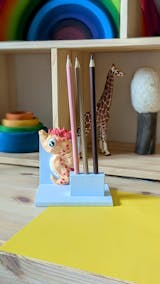The kids loved making Ice Cream Octopus. With very minimal guidance, our 8 and 5 year old created a fabulous Ice Cream Octopus pencil box just like the image. They were so proud and it looks very cute. A great gift or school holiday activity. (Gifted for review)
This was a very engaging activity for a 10 year old (and her Mum!). The main clay activity kept them both engaged for an hour or more, and the end result came out really well. There are a lot of secondary activities to tackle as well, so all in all, a well thought out gift.
This is a fantastic kit for the kids.Coming with all you need to create a beautiful little pen holder, it's ready to go. Pros..... Nicely presented item, making it a perfect gift option.. Complete and easy to understand instruction and shaping guide.. Lots of fun whilst encouraging creativity.. All you need is right there in the box.Definitely a fun kit to help the kids with.
This was a fantastic little kit. I gave it to my nephew for his recent 4th Birthday, and despite falling 2 years under the agerecommendation (6-9 years) he was able to follow the instructions and make a "passable" dino creation (with a pinch of supervision here and there). As a massive Dino fan, he was over the moon and was very excited to make it right away.Now, for the parents considering this product, one of the best elements is the lack of "junk" left over. You probably have homes that are brimming with abandoned toys, but this item is different. When your kid is finished, you're left with a useful stationary item that they can keep in their room!A great, "largely" mess free, and creative gift idea!
What’s not to like about the craftenly air dry clay kit.It’s fun, easy to use and well thought out.Pictures, and written information to help with assembly.Would purchase again.
This kit is beautifully boxed and has all materials and tools to make an octopus with cone from air dried clay. There is a booklet with detailed instructions and templates to help make sure the pieces are the correct size.
I gave this craft box to my daughter for her birthday and she enjoyed it so much
Great way to keep her entertained, learn through the step by step instructions and have a cute pen holder for her favourite pencils
My son had alot of fun doing the wise owl craft, it turned out so cute and of course very handy to hold his pens !! Great quality .
This seems like a simple clay project with no baking of the clay. There are not many pieces to the activity but the clay Dino may take a bit of fiddling.To help with little fingers there are lots of instructions that actually show pictures of what to do. Plus there is a template for each part of Dino so kids know the size to make each part.Once you make your Pen Holder, the box can be used as a hold-all for children's treasures.This is a quality craft activity with excellent instructions.
We absolutely loved our Shiny Seahorse Clay Activity Kit from Craftenly. Everything we needed was in the box, including all the materials, tools and very easy to follow instructions. Our 4 year old proudly created his Shiny Seahorse Pen Holder, which has been used multiple times since he made it.

















